DS Games To Watch in 2005
Part One: The Stuff That's Finished. With so many DS games to get through, we've split this one in two. First up, the games we've played. Join us this afternoon for all the rest.
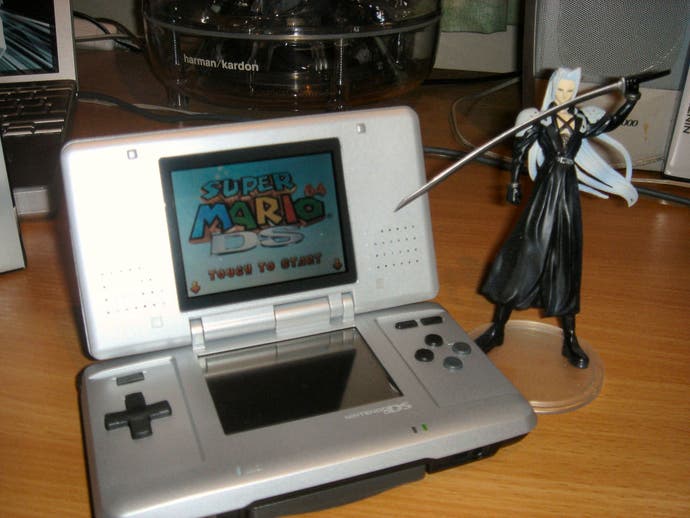
In looking forward to the highlights of the 2005 calendar year on the Nintendo DS, it's not just the games that European fans have to get excited about; it's the console itself. Following an extremely popular launch in the US in late November and a similarly encouraging lift-off in Japan under a fortnight later, those of us waiting patiently in the middle can mark a couple of key dates on the novelty calendars we got for Christmas before starting to worry about which games to buy. First there's the end of January, when Nintendo is expected to announce European launch details including a £129.99 price point at a press event in France, and then there's late March (possibly the 25th), when the system is finally expected to go on sale.
It's certainly going to be interesting to see how it fares. Although the DS has already enjoyed massive sales in the States (with 1.3 million units sold through by the end of December according to Nintendo) and, along with a resurgent GameCube and the consistently popular GBA SP, helped the platform holder dominate the end-of-year charts in Japan (where at the time of writing there are still three DS titles in the top ten), the real test will come when it launches in a European market that fully expects to wander down the high street at the end of March with a wad of notes and choose between similarly priced Nintendo DS and Sony PlayStation Portable units - the latter having done a far better job in import circles of wowing people with its technological achievements, huge screen, media versatility and captivating good looks.
With Rockstar having just confirmed plans for what we assume will be a fully 3D Grand Theft Auto title on the PSP - and particularly given that franchise's enormous popularity in the UK, proportionally that much greater even than it is in the States - the near-simultaneous launches, if they go off as expected, could put the DS on a significantly weaker footing than it enjoyed in the US and Japan - despite the depth of its software line-up and the intriguing nature of its hardware, with its dual screens, stylus and microphone control options, wireless networking and all the rest.
For now though, we'll offer no predictions as to who will come out on top. Until we've heard the launch details of both consoles, particularly the software line-ups, it'd be churlish to do so. We're not going to rehash old features and discuss the hardware or built-in software side of it to any great degree either - as by now you almost certainly know what a Nintendo DS is and does, and how we feel about it. If you really are still clueless, feel free to refer back to our in-depth first impressions of the unit, and click on some of the review/impressions links scattered around this page. But what we are going to do, as we get ready for arguably the most pivotal year handheld gaming has ever experienced, is talk about the software. And, to draw it all to the point, if there's one thing that tougher competition in Europe is likely to be good for it's encouraging Nintendo to fight its corner with more and better games.
UPDATE! Ah, the curse of the commentator. Not long after we originally published this piece, Nintendo Australia (of all people) cast doubt on European projections of a March date and £130-ish price tag, with the suggestion now being that we could see the DS on store shelves in Europe as early as 24th February at a price of around £100 - which would almost certainly make a difference to the outcome of the impending handheld war. At this point though, all bets seem to be off. Keep your eyes on the front page over the next few weeks, however, and all will hopefully be revealed.
The Stuff That's Finished
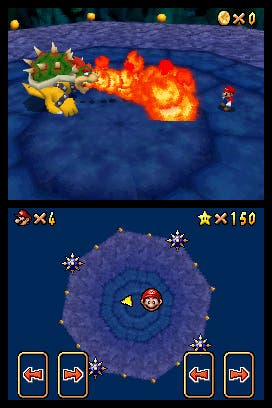
Super Mario 64 DS (Nintendo, US review, further discussion)
European release date: launch - estimated March
The flagship game for the Nintendo DS and arguably the best game you can buy for it at the moment in the US or Japan. Super Mario 64 DS is a port of the N64 game, itself a pivotal moment in 3D platforming and one of the finest examples of the genre, expanded to include a great many more tasks (and, on the off-chance we're not preaching to the choir in some quarters here, tasks in Mario 64 involve retrieving a star by completing some feat of 3D platforming ingenuity, of which there are quite a few in any given level) as well as an array of mini-games. The main single-player platform game can be controlled in various ways - there's a traditional D-pad and face buttons approach, which is a bit trickier than the N64 analogue equivalent due to the need to hold another button to get Mario to go from walking to running; and there are also stylus and thumb-strap approaches that create a virtual analogue "zone" on the DS's touch-screen, radiating out from where you first touch down with chosen implement, and map Mario's various jumps and other abilities either to the D-pad or the face buttons, allowing right and left-handed gamers to get the most out of either approach. Graphically it's much the same as its N64 predecessor, albeit somewhat less fuzzy, and the DS never struggles to display the game world, and, in terms of what you can do, apart from having more stars to uncover you'll also have a total of four characters to unlock and make use of, some of whom have to be brought into play to tackle particular tasks at all.
Perhaps the real revelation though comes by way of the mini-games, of which there are absolutely loads to unlock beyond the first eight or so that you can play from the get-go. We'll leave it to you to figure out how to get at them all, but you will certainly want to, because at the moment they are the best examples of how different and intensely rewarding gaming on the DS can be - and many of them manage to not only play to the strengths of the control system but also make good use of both screens. Our favourite, and the example we often dredge up, involves drawing lines between vertical poles on the touch-screen so that Mario's head, which is descending on a similar array of linked poles on the top screen, ends up colliding with a star and not with one of the three piranha plants at the bottom. There are variations, tougher versions of the game, and a huge array of completely different but rarely less than entertaining efforts that regularly leave you smiling in a way that only a truly quirky Nintendo game seems to be able to make you smile. Like dragging different-coloured bombs into boxes on either side of the screen before they have a chance to go off. Or sling-shotting bombs as they parachute down towards your castle. Or... Well, we could be here all day. Suffice to say, despite a few notable flaws covered in our review and subsequent panel discussion late last year, Super Mario 64 DS just makes us jibber and jabber endlessly, and if there's a game that we'd single out as the DS's most promising launch prospect, this is undoubtedly it.
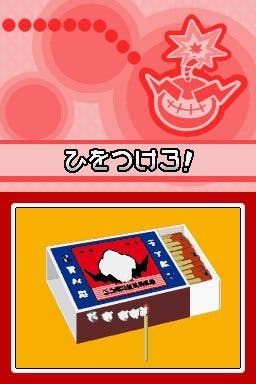
Wario Ware Touched! (Nintendo/Intelligent Systems, Japanese review)
European release date: TBC - estimated at launch or thereabouts
At one point during our write-up of the Japanese version of Wario Ware for the DS, we simply had to stop ourselves and admit that taken in isolation this is working to an exceptionally high standard, and harbours more entertainment and ingenuity in its ditty little game card than a hundred mini-game compilations we've encountered over the years. Which makes it a bit easier to stomach the fact that it's not quite as good or inventive as the original GBA Wario Ware, Inc. We'll not rehash that debate; read last week's review if that's what you're after. Instead, we'll concentrate on what it does well, which ought to give us more than enough to say.
First of all, it successfully transfers the Wario Ware formula (a succession of short, sharp, five-second-or-less bursts of simple and often obscure mini-games that you're expected to complete quickly using limited controls) successfully to the DS, inventing a plethora of new tasks catered to stylus (and, in one section, microphone) control that are imbued with the same playful spirit, neatly split into sensibly-chosen groups, and culminate in longer but charismatic boss battles that demand from you, for example, the ability to drag a globe icon out of the path of laser-fire in a scrolling shoot-'em-up. And the tasks, though some of them are too simple, will make you smile more often than not. It'd take a true miser not to extract some joy from this game, and it's one of those that's likely to have you coming back again and again even when you've finished it - whether it's just to replay the same sections and see how many games you can get through without coming unstuck, or you want to try the full-length versions of some of the mini-games, or you want to replay specific tasks or bosses endlessly, or you just want to gawp at the ridiculous presentation and nonsensical cartoon sequences. It may not have earned top marks, but when it comes to launch we'd still buy it, even knowing what we know now.
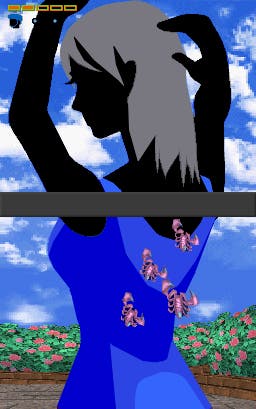
Project Rub (SEGA/Sonic Team, US review)
European release date: launch - estimated March
Known somewhat inexplicably to Americans as Feel the Magic: XY-XX and to the Japanese as Kimi no Tame Nara Shineru ("I Would Die For You"), this is another mini-game compilation, albeit one strung around the premise of a young man courting a young lady - and trying to impress her/rescue her/satisfy her at every turn. The original Japanese version apparently involved a lot more story than the American edition, which probably explains why we had such difficulty reconciling ourselves with the "dating game" description many have bestowed upon it, but in the end it's no matter because the real draw here (if you'll excuse that pun for the four-hundredth time) is the quality of the tasks Sonic Team has dreamt up. Some of them are frankly rubbish, or poorly balanced, and it gets a bit repetitive as you go on, but then some of them are utter genius. Dragging the stylus over a narrowing series of walkways to have our hero unicycle between skyscrapers is a virtual buzz bar, shuffling litter out of the way so that our hero's friends can scoot downhill in shopping trolleys is as entertaining as it is ridiculous, and sneaking into a building by distracting security guards with carefully positioned screeching cats is the sort of thing that the DS was invented for - and the sort of thing you can't find anywhere else, however easy it might be to make it work on a regular machine. It doesn't always take full advantage of the hardware at its disposal, but like Mario 64 DS and Wario Ware Touched! the mini-games on offer here (available in increasingly tough versions, usefully) are the sorts of things you'll come back to again and again, and happily show off to random people on the Tube again and again and again.
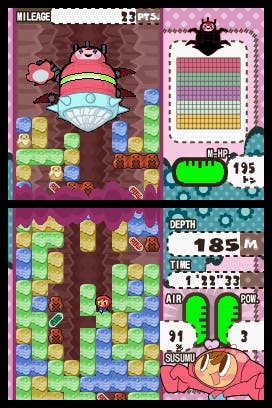
Mr. DRILLER: Drill Spirits (Namco, US review)
European release date: TBC - but we'd bank on launch or thereabouts
An unexpected pleasure, this. Unexpected because a) this writer hadn't really tackled Mr. Driller for flipping ages beforehand and had forgotten why it was so enjoyable, b) the removal of a particular game mode and single-cartridge multiplayer options from the US version put it at an immediate disadvantage, particularly given how much we paid to get our hands on it, and c) we found it so fascistically difficult, and still do. Yet we gave it a big score. The reason being, quite simply, that no matter how silly it may sound that the main game mode doesn't even need the top screen and is actually worse off with the stylus control, no matter how frustrating it might be to know there are modes out there (including desirable multiplayer options) that we haven't experienced, and no matter how many times it made us scream bloody murder and angrily throw the machine down in disgust (or rather, given the reality of the costs involved, incandescently place it back on the table), we just couldn't stop playing it.
The main Mr. Driller mode involves digging and digging at various interlinked blocks, trying not to get crushed and trying not to run out of air and die. It doesn't take long to get the hang of how it works, but it takes ages to master. Whether you find it easy or hard though, it takes even longer to get bored of and put it away, and the rich, vibrant colours of the DS screen make ever so slightly more enjoyable than it might have been on the GBA, while the system itself gives it the portability that the home console versions we've previously seen over here obviously couldn't. But it's the clever introduction of the shop, opening the door to power-ups that make life and progress easier but make it harder to bank more currency, and the show-stealing Pressure Driller mode, that make it such a compelling title. Pressure Driller is basically normal Mr. Driller with a great big nasty bastard hurtling after you, ever visible on the top-screen. The idea is to kill him off by collecting power-ups on the way down and firing them back up when he exposes certain areas of his frame, which is needless to say both challenging and distinctive compared to the main game. And the fact that he's about the size of one of those things that dug the Channel Tunnel, not to mention pacey and always seemingly right on your trail, mean that it's incredibly hard to stop. Unless of course you're stopping to go back to the main Driller mode.
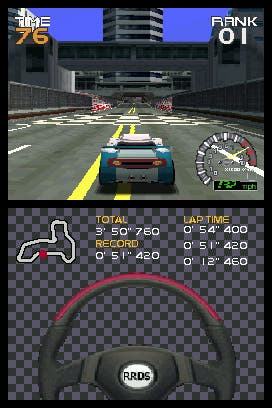
Ridge Racer DS (Namco/NST, US review)
European release date: TBC - but launch seems probable
The temptation was there not to include this, because, in all honesty, it's not a game we're particularly looking forward to playing again. Controlling the game using the stylus or thumb-strap didn't come easily, and the fact that it's a port of Ridge Racer 64 - one of the weakest games in the usually strong Namco racing series - just makes it worse. But we're including it nonetheless because we recognise we think worse of it than some others, and because if you can get the hang of the controls (seriously, even the D-pad/face buttons approach made us angry) then it's the best racing game on the DS. Admittedly its only real competition is Asphalt Urban GT, which is so appalling by all accounts that we haven't even bothered to import it, but still. If you are after a racing game for the DS, you might like to wander down to your nearest gaming shop come release and ask for a quick demonstration. It's got quite a few tracks, plenty of cars, and faultless wireless multiplay, and the fact that we can't quite contain the bile we'd like to spit upon it shouldn't put you off finding out about it for yourself.
But, given that the PSP is very likely to be lurking just a few feet away when you do get round to pondering it, we might suggest that those of you after next-gen handheld racing take a long hard look at Sony's handheld and the rather excellent Ridge Racers that, having had both since before Christmas, we've probably played about five or six times as much.
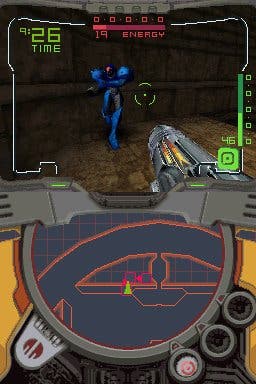
Metroid Prime Hunters: First Hunt (Nintendo/NST, US first impressions)
European release: First Hunt demo will be available at launch, full game TBC
This one just about makes it into the "Stuff That's Finished" category, as long as we're clear that we're referring to the First Hunt demo that comes bundled with the DS itself, and not the full version - about which we don't really know a great deal. First Hunt, though, is a fairly enjoyable little bundled trinket, and kept us amused for quite a few hours - even on our own. It's split between single-player training tasks and wireless multiplayer. The training involves a bit of light platforming, a lot of shooting, and rolling Samus in morph ball form around a course against the clock - and while the former tasks more or less convince you that this sort of first-person action game can work on the DS (and look bloody lovely into the bargain), the latter demonstrates the physicality of the 3D environment rather concisely and throws down a gauntlet that you'd have to say is squarely aimed at SEGA and its Monkey Ball making fellows in the department formerly known as Amusement Vision. Or at least that's how we'd interpret it. The multiplayer side of things, meanwhile, will keep you going for quite a while - it consists of three deathmatch levels geared towards between two and four players, and the wireless implementation is as flawless as the action has the potential to be engrossing. We still wait to be completely convinced by Metroid Prime Hunters, but it's clear Nintendo's keen to get this one right, as evidenced by the change in control schemes between E3 and launch and the platform holder's reluctance to send the full game out until it's completely ready. As a freebie to play when you're not hunting stars or riding unicycles, though, you can't really argue with First Hunt.
Next: The Ones We Know Things About, and The Wow-Them-With-Names Brigade...








